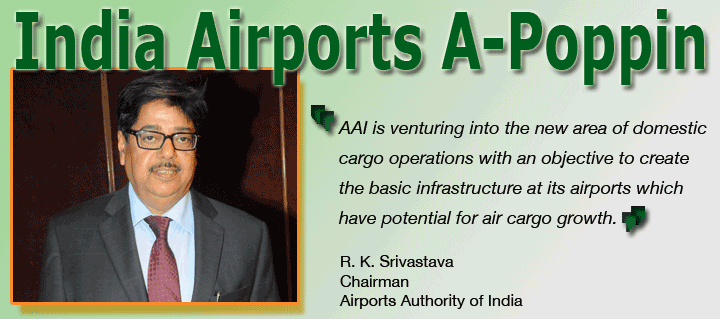
The government-controlled
Airports Authority of India (AAI) has, at last, woken
up to the potential of air cargo in the country. In
a move that could change the manner in which AAI goes
about its business, AAI has chalked out a strategy for
air cargo. AAI Chairman R. K. Srivastava was candid
enough to point out that the cargo business “had
not been attended to in the last 60-70 years…
It has been ignored for too long.”
The business strategy
that has been worked out comes on the heels of the realization
that air cargo—both domestic and international—is
growing at a fast pace. The growth will be pushed further
with the Civil Aviation Ministry’s emphasis on
bringing about regional connectivity (the new draft
Civil Aviation policy, in particular, underlines this).
In fact, a number of regional airlines—those connecting
metro cities to Tier-2 and Tier-3 towns—have already
started operations. For example, Air Costa, with headquarters
at Vijayawada in Andhra Pradesh, has been in operation
since October 2013. The carrier has a cargo unit.
The phenomenal growth
in domestic passenger traffic (according to IATA figures,
India’s domestic air traffic demand grew 20.5
percent in the year to July compared with the previous
year) will continue gradually when the Civil Aviation
Ministry finishes upgrading unused airports and even
some airstrips built during World War II. All these
together would also spawn cargo from smaller towns.
For its part, AAI has
decided to establish a new entity for the cargo business.
It has contracted the government-run infrastructure
consultant RITES to work out a business model. Srivastava
pointed out why AAI had decided on a new business entity.
With more connectivity, there would be new cargo opportunities
and only after RITES works out the options on ways to
handle the cargo business would AAI decide on the business
model.
Further, AAI has started
working out plans for internal reorganization to accommodate
the growth so that it can function to the best of its
ability when new regional airports are added. Once that
is done, the authority hopes to attract skilled manpower.
This will be especially advantageous for the cargo business,
which has the highest component of unskilled personnel.
Incidentally, the draft civil aviation policy mentions
that air cargo would be an employment generator.
The AAI Chairman also
said that well before the Draft Civil Aviation Policy
came, the authority had aimed to invest a total of Rs
20,000 crore over the next five years in order to add
capacity for 50 million passengers. Now, with the policy
becoming a reality by April 2016, there was a need to
create the necessary infrastructure to accommodate a
hike in the capacity—of 100 million passengers—over
the next seven years.
In fact, in the beginning
of this year Srivastava mentioned at a press conference
that, “AAI is venturing into the new area of domestic
cargo operations with an objective to create the basic
infrastructure at its airports which have potential
for air cargo growth.” Since “domestic cargo
grew by 10 percent and international by five percent
last year,” the Chairman said that with the growth
of air cargo at metro and non-metro airports, there
was considerable scope to tap the potential and therefore
there was a need to improve and better the basic infrastructure.
In talks with this correspondent,
the Chairman said, “India was now poised to take
a big leap in manufacturing, development of infra-structure,
and e-commerce for which logistics plays a vital role.”
He also mentioned that
“understanding the need for rising to the occasion,
AAI is now ready to take a lead in developing domestic
air cargo in the country. We are already in the process
of developing 24 domestic airports for Common User Domestic
Cargo Terminal, which will facilitate exploiting the
full potential of domestic cargo. This process will
be further accelerated through focused approach for
developing more and more domestic cargo operations in
the coming days.”
Tirthankar Ghosh |





